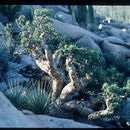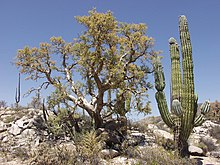zh-TW
在導航的名稱


Pachycormus discolor ist die einzige Art der monotypischen Pflanzengattung Pachycormus innerhalb der Familie der Sumachgewächse (Anacardiaceae). Sie kommt nur in der Baja California und ganz im Nordwesten von Mexiko vor. Die Art trägt auch folgende Volksnamen: "Copalquin", "Torote Blanco" und "Elefant Tree" (Elefantenbaum).
Pachycormus discolor wächst baumartig, halbimmergrün und wird 3 bis 5, manchmal auch bis 10 Meter hoch. Die zweihäusigen Pflanzen mit knorrigen Ästen können einen kurzen, teils geschwollenen Stamm mit einem Durchmesser von bis zu 1 Meter ausbilden. In dem sehr weichen Holz ist ein gelblicher, rötlicher, bräunlicher oder milchig, harziger Saft enthalten. Die Rinde ist hellocker gefärbt und blättert in papierartigen Stücken ab.
Das wechselständige Laub erscheint nach der Trockenzeit. Die mehr oder weniger unsymmetrisch unpaarig gefiederten, meist leicht behaarten, kleinen und gestielten Laubblätter werden 1,5 bis 8 Zentimeter lang und 0,7 bis 3 Zentimeter breit. Es sind bis etwa 10 meist sitzende bis fast sitzende, abgerundete bis rundspitzige, ganzrandige bis gelappte Blättchen vorhanden, das Endblättchen ist meist gelappt oder grob gezähnt.
Der feinhaarige und achselständige Blütenstand wird aus einer lockeren und endständigen Rispe gebildet. Die eingeschlechtlichen, duftenden, fünfzähligen und gestielten Blüten mit doppelter Blütenhülle sind cremefarben bis gelblich-weiß oder rosafarben bis rötlich. Es sind jeweils fünf kleine, schmale und spitze Kelchblätter vorhanden. Die ebenfalls fünf feinhaarigen, außen gekielten Blütenblätter sind länglich eiförmig. Im Lauf der Blütezeit verblassen die Farben der Blütenblätter und verbleiben ausgetrocknet länger am Trieb. Es werden zehn kurze Staubblätter ausgebildet und der Fruchtknoten besitzt nur eine Kammer. Die drei kurzen Griffel sind mit kopfigen Narben ausgestattet. Bei den männlichen Blüten kann ein reduzierter Pistillode vorkommen, bei den weiblichen Staminodien. Ein dünner Diskus ist vorhanden.
Die Oberfläche der kleinen Frucht (Utrikel) in den beständigen Petalen ist mit kurzem Filz besetzt.
Pachycormus discolor ist auf der Baja California verbreitet.
Die Erstbeschreibung der Gattung Pachycormus erfolgte 1923 durch Frederick Vernon Coville.[1] Als Synonym für die Gattung gilt die ungültige Beschreibung der Gattung Veatchia durch Asa Gray 1884 mit der Typart Veatchia cedrosensis A.Gray.
Die Erstbeschreibung der Art erfolgte 1844 durch George Bentham als Schinus discolor Benth.[2] Mit Beschreibung der Gattung Pachycormus durch Coville wurde die Art ebendort eingegliedert. Zur Art existieren eine Vielzahl von Synonymen, wie Veatchia discolor (Benth.) Brandegee, Rhus veatchiana Kellogg und Bursera pubescens S.Watson.
Auf Grund der Variabilität der Art existieren drei Varietäten (Pachycormus discolor var. discolor, Pachycormus discolor var. veatchiana und Pachycormus discolor var. pubescens), die sich in Merkmalen der Blätter und des Blütenstandes unterscheiden. Sie sind jedoch durch Übergänge miteinander verbunden.
Pachycormus discolor ist die einzige Art der monotypischen Pflanzengattung Pachycormus innerhalb der Familie der Sumachgewächse (Anacardiaceae). Sie kommt nur in der Baja California und ganz im Nordwesten von Mexiko vor. Die Art trägt auch folgende Volksnamen: "Copalquin", "Torote Blanco" und "Elefant Tree" (Elefantenbaum).
Pachycormus is a monotypic genus of flowering plants in the cashew family commonly known as the Baja elephant tree, torote blanco, or copalquín.[3] The single species Pachycormus discolor is endemic to the Baja California peninsula, with three varieties. This sarcocaulescent tree or shrub is characterized by its unique gnarled growth habit, skin-like exfoliating bark, and succulent nature, whose appearance has been colorfully described as "the proboscis of an elephant holding a nosegay," a "huge radish protruding from the ground," or "grotesque resemblances of the flexed limbs of a corpulent human being."[4] This drought-deciduous species spends most of the year dormant, but following rains pinnate green leaves emerge, and in the late spring to summer the leaves yellow, fall, and give way to bright red, cream, or pink flowers that give it a striking appearance in bloom.[4][5]

This species is a tree or shrub (rarely) with a gnarled growth habit that can result in bizarre shapes and forms. On the Pacific coast, in areas with strong coastal winds, the growth habit is usually prostrate or sprawling. The trunk is usually 60 to 80 cm (24 to 31 in) in diameter and covered in a smooth, exfoliating, skin-like epidermis (the outer bark). Beneath the papery outer bark, which exfoliates annually, is a spongey, blue-green photosynthetic inner bark 2.54 to 5.08 cm (1.00 to 2.00 in) thick. The inner bark exudes a milky sap that dries clear and hardens into a gum or resin.[4][5][6]
The leaves are dark green, pinnately compound, pubescent, and drought deciduous, yellowing first before they drop. There are 3 to 15 leaflets, measuring 3 to 10 mm (0.12 to 0.39 in) long and shaped oval or oblong. The herbage is puberulent. Leaf size is variable within the infraspecies. The inflorescence is a panicle. The flowers are dioecious, and are colored yellowish, pink or red (the color varying per variety). The petals are accrescent, about 5 mm (0.20 in) long and with an acute tip. The fruits are shorter than the petals, and are pubescent.[4][5][6] The flowers appear in May, and can bloom into September, depending on moisture levels.[7]

The generic name refers to the Greek pachy for "thick" and kormos for "trunk," referring to the thick caudiciform trunk.[8] The common name is derived from the thick size of the trunk relative to the tree, like that of an elephant.[5] The common name "elephant tree" is also applied to Bursera microphylla as well as other species.[9]
This species is endemic to the Baja California peninsula of Mexico, occupying the states of Baja California and Baja California Sur. The three varieties are subsequently endemic to their own parts of the peninsula. San Fernando Velicatá delimits the northern vicinity of this species, with variety pubescens found from there to the lower part of the peninsula near La Paz and various Gulf islands. In the far western parts of the peninsula, var. veatchiana occupies the western margins of the Vizcaino desert, Cedros Island, and the Natividad islands. In the south-western part of the peninsula, var. discolor is found on the islands of Magdalena Bay and the western flanks of the southern Sierra de La Giganta.[5][10]
This species is primarily restricted to the Baja California desert and the Vizcaino desert, but can also be found in more temperate montane habitats, such as in the mountains of the Sierra de La Giganta and the Gulf islands. In the Sierra de La Giganta, the variety discolor grows sparsely on the mountain sides, but in ravines it can form impenetrable groves, and is found from sea level to an elevation of 1,500 ft (460 m).[4] On Cedros Island, var. veatchiana is found in alluvial fans and canyons, growing tallest in these locations, and also coastal localities where it takes a prostrate form, in the desert parts of the island.[11]
Typical habitats of this species in the north and central parts of its range (Laguna Chapala in Baja California and San Ignacio in Baja California Sur) are characterized by high temperatures in the summer, usually 34 to 45 °C (93 to 113 °F) in the day, and with temperatures that can fall to 3 °C (37 °F) on mild winter nights. Rain is mostly a result of Eastern Pacific hurricanes from August to October, but some years have no rainfall at all while others receive some winter rain from the north.[12]
Plants are grown in containers by caudiciform succulent aficionados. Plants do best in full sun. Only seed grown specimens develop the caudex. This species is marginally frost tolerant, with tip damage at 32 °F (0 °C), death at 25 °F (−4 °C).[7]
Considerable quantities of the bark were once exported to Europe for use in tanning.[6]
Pachycormus is a monotypic genus of flowering plants in the cashew family commonly known as the Baja elephant tree, torote blanco, or copalquín. The single species Pachycormus discolor is endemic to the Baja California peninsula, with three varieties. This sarcocaulescent tree or shrub is characterized by its unique gnarled growth habit, skin-like exfoliating bark, and succulent nature, whose appearance has been colorfully described as "the proboscis of an elephant holding a nosegay," a "huge radish protruding from the ground," or "grotesque resemblances of the flexed limbs of a corpulent human being." This drought-deciduous species spends most of the year dormant, but following rains pinnate green leaves emerge, and in the late spring to summer the leaves yellow, fall, and give way to bright red, cream, or pink flowers that give it a striking appearance in bloom.
Pachycormus es un género monotípico de plantas, perteneciente a la familia de las Anacardiaceae. Su única especie: Pachycormus discolor (Benth.) Coville, es originaria de México en Baja California.
Los árboles alcanzan un tamaño de 5 m de alto y de ancho, son ligeramente tolerantes a las heladas. Las plantas se desarrollan mejor a pleno sol. La corteza exterior exfoliante es de color blanco que revela una corteza interna azul-verde, fotosintética. Las hojas de color verde oscuro, pinnadas, pubescentes, de hojas caducas cuando hay sequía. Flores de color crema con centros rosados que aparecen en mayo, y pueden florecer en septiembre, en función de los niveles de humedad.[1]
Pachycormus discolor fue descrita por (Benth.) Coville y publicado en Century Dictionary and Cyclopaedia (rev. ed.): 6708, en el año 1911.[2]
Pachycormus: nombre genérico que deriva de las palabras pachy para "gruesa" y kormos para "tronco", en referencia al grueso tronco.
discolor: epíteto latino que significa "sin color".
Pachycormus es un género monotípico de plantas, perteneciente a la familia de las Anacardiaceae. Su única especie: Pachycormus discolor (Benth.) Coville, es originaria de México en Baja California.
Pachycormus discolor là một loài thực vật có hoa trong họ Đào lộn hột. Loài này được (Benth.) Coville mô tả khoa học đầu tiên năm 1911.[1]
Pachycormus discolor là một loài thực vật có hoa trong họ Đào lộn hột. Loài này được (Benth.) Coville mô tả khoa học đầu tiên năm 1911.
Pachycormus Coville (1911)
Единственный видПахикормус (лат. Pachycormus, от др.-греч. παχύς — толстый и κορμός — ствол) — монотипный род растений семейства Анакардиевые (Anacardiaceae).
Единственный вид — Пахикормус разноцветный (Pachycormus discolor), известный также как слоновое дерево.
Двудомные деревья 4,5—6 (9) м высотой. Ствол короткий, с основанием до 90 см в диаметре. Ветви искривлённые, до 6 м длиной. Листья опадающие, очерёдные, непарноперистые, черешчатые; листочки эллиптические.
Цветки на ножках, собраны в пазушные метёлки; покровы цветка пятираздельные, белые, бледно-розовые или розовато-красные, расчленены на чашечку и венчик. Тычинки располагаются в два круга. Плодолистиков и стилодиев 3, рыльца головчатые.
Плод — пушистый одногнёздный мешочек.
Эндемик центральной части штата Нижняя Калифорния (Мексика). Суккулент, растёт на каменистых склонах до 1500 м над уровнем моря.
Пахикормус (лат. Pachycormus, от др.-греч. παχύς — толстый и κορμός — ствол) — монотипный род растений семейства Анакардиевые (Anacardiaceae).
Единственный вид — Пахикормус разноцветный (Pachycormus discolor), известный также как слоновое дерево.